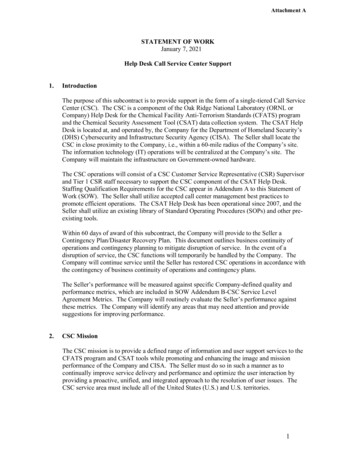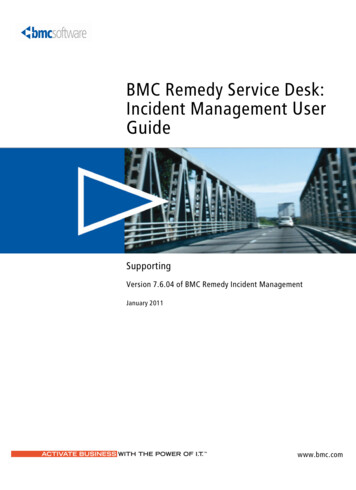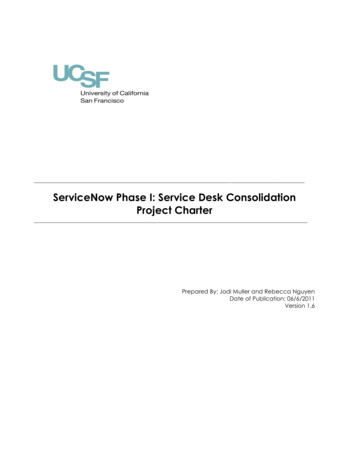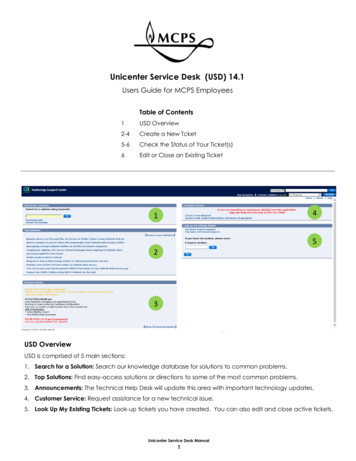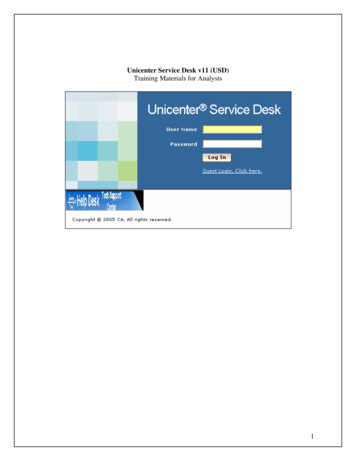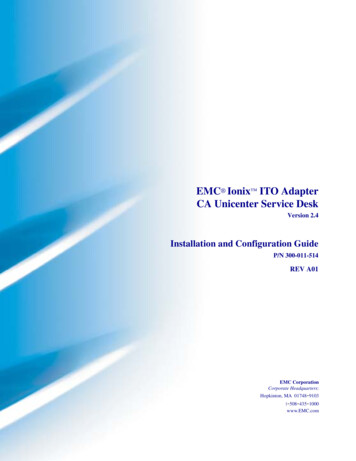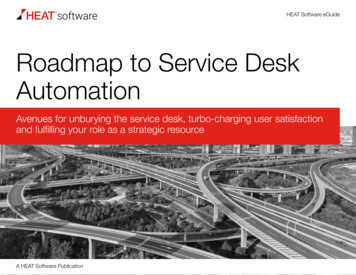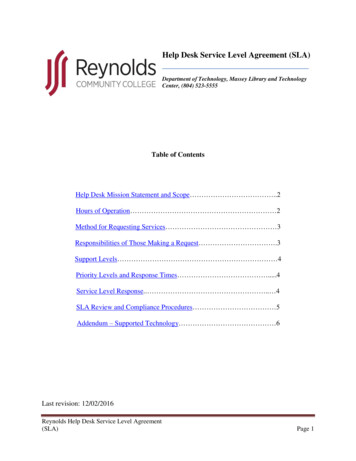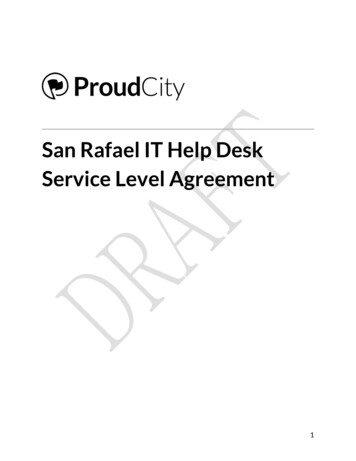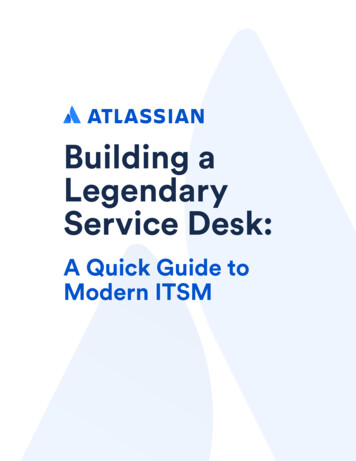
Transcription
Building aLegendaryService Desk:A Quick Guide toModern ITSM
ContentsIntroductionThe Great Service DeskOpportunity03Chapter 1What Is ITSM Anyway?04A. Incident Management08B. Service Request Management11C. Knowledge Management14Chapter 2Why ITSM Matters NowMore Than Ever16Chapter 3Doing ITSM The Atlassian Way18Next Steps: See It In Action24Conclusionatlassian.com
IntroductionThe Great ServiceDesk OpportunityFor a few decades, IT was mostly back office nerdery. We fixed computers and atedonuts. Help desk workers reset passwords. We certainly weren’t seen as strategic.And then we arrived. Today, IT has become the backbone of nearly every business inthe world, from Silicon Valley startups to global mining and manufacturing titans. Theservices you provide are no longer “nice to haves” — they’re business critical.Which creates a huge opportunity: In an era defined by amazing experiences andrising expectations, how can service desk evolve? How can you combine strongITSM frameworks like ITIL with modern tools that improve efficiency, collaboration,and customer satisfaction?That’s exactly what you’ll learn in this guide. We’ll cover the three most commonprocesses that every service desk should adopt, discuss why ITSM is a criticalcomponent of meeting rising customer expectations, and even introduce you tohow Atlassian technology can help.The result? You’ll be well on your way to delivering legendary IT service to yourcustomers. So let’s get started!atlassian.com
Chapter 1Doing ITSMThe Atlassian WayA refresher course: What is ITSM anyway?It’s always nice to start with a painfully wordy, formal, and vague definition, likethis one for IT Service Management (ITSM) from Wikipedia:A discipline for managing information technology systems,philosophically centered on the customer’s perspective of IT’scontribution to the business. ITSM stands in deliberate contrast totechnology-centered approaches toIT management and business interaction.What does it all mean? ITSM is really just about improving business performanceby taking a more strategic approach to IT service delivery. It’s a long acronym for asimple concept: making sure you have the right people, processes, and technologyto provide great service to your employees and help your business hit its goals inthe process.To help you do that, the UK government created yet another acronym —ITIL — in the late 1980s to provide a more formal set of guidelines for effectivelyimplementing ITSM. Short for Information Technology Infrastructure Library,ITIL has evolved into a series of recommendations to help your IT team improvesupport processes and align IT services with business needs.atlassian.com
05 of 24What is ITSM anyways?A bit more about ITILAlthough the most recent version of ITIL covers 26 different processes split acrossfive disciplines, very few organizations use all of these processes. Instead, mostchoose to adopt (and even adapt) those that best meet their unique needs.A few of the most commonly adopted ITIL processes, and the ones we will focusthe most on in this guide, are: Incident management - Returning service to normal as quickly aspossible after an incident, with little to no negative impact on the business. Problem management - Preventing problems and resulting incidentsfrom happening, eliminating recurring incidents, and minimizing the impactof incidents that cannot be prevented. Service request management - Ensuring that customers have easyaccess to the IT services (and information, equipment, advice, etc.) theyneed to get their jobs done. Knowledge management - Gathering, analyzing, storing, and sharingknowledge and information to improve efficiency. Change management - Ensuring that standardized methods andprocedures are used for efficient and prompt handling of all changes(to code, infrastructure, configurations, services, etc.) in order to minimizethe impact of change-related incidents on service quality.You can read entire volumes of books about each one of these ITIL processes, ifthat’s your thing. The key thing to know is that you don’t have to. At Atlassian,we’ve created simple, fully integrated tools for quickly and effectively adopting amodern approach to ITSM based on ITIL best practices.Since we know you don’t have the time to binge-read a few hundred pages, we’rekeeping this guide focused primarily on incident, service request, and knowledgemanagement to start. We’ll also cover Atlassian technology a bit. For now, justremember that you don’t have to create and implement complex processes fromscratch to set up an agile, ITIL-compliant service desk.atlassian.com
What is ITSM anyways?06 of 24Wait, you said service desk.How is that different from a help desk?Glad you asked. Throughout the 2000s, the terms were often usedinterchangeably. In reality, they’re quite different. Historically: The IT help desk was an IT support capability born in the late 1980s tofix purely IT issues. There was zero focus on the end user, and immediatefixes were infrequent. The service desk is an evolution of the help desk, born out of the ITILframework, with a focus on the concept of “managing IT as a service.”It’s not just about fixing internal IT problems — it’s about improving ITand business processes across the entire organization.In fact, help desks are often just a single component of a larger servicedesk operation, focused exclusively on break-fix (or what ITIL calls incidentmanagement). The larger service desk operation encompasses not only break-fix,but also requests for new services and requests for information(such as “how do I do X?”). As such, ITIL experts will state that a help desk istactical, while a service desk is strategic.atlassian.com
07 of 24What is ITSM anyways?In the end, what you name it is the least important part of running a top-notchITSM practice. Forty-one percent of help desks and service desks are namedsomething else entirely, according to HDI.The support center is referred to as.Respondents were asked to select the closest match to their support centre’s title.Service Desk36%Help Desk23%Technical Support9%IT/IS Support9%Support Center7%Customer Support Center5%Customer Service Center5%Call Center3%Contact Center3%Percentage of support centersWhat’s more important you ask? Delivering great service that reinforces the valueof IT. And to do that, it’s helpful to start with best practices — adopting andadapting core ITIL processes to meet the needs of your company, and embracingtechnology that makes it far easier.Let’s take a closer look at these core ITIL processes, and some toprecommendations for implementing them at your own service desk.atlassian.com
What is ITSM anyways?08 of 24IncidentManagementIn ITIL-speak, incidents are just unplanned events of any kind that disrupt or reducethe quality of service (or threaten to do so). An incident is a business applicationgoing down. A crawling-but-not-yet-dead web server can be an incident, too. Forsome offices, a refrigerator without beer is an incident.A problem, on the other hand, is just the not–yet-known root cause behind oneor more underlying incidents. For example, if a printer is down and the network iscreeping, a misconfigured router could be the underlying problem behind both.Since the goal of incident management is to restore a service as quickly aspossible, the service desk is not expected to perform root cause analysis toidentify why an incident has occurred. Root cause analysis is the focus of adifferent ITIL process called Problem Management. However, it’s important thatthe service desk team capture all relevant information while working on the issue,which will help both with eventual problem investigations and with responding tofuture similar incidents.When the service team responds to incidents, they should follow a predefinedprocess to streamline the response and reduce the risk of prolonged serviceoutages. The following process represents an example incident response basedon ITIL recommendations. Your team can adapt the example to your existing ITILprocesses, or use it to define new ones.atlassian.com
09 of 24What is ITSM anyways?Incident ResponseIncident ReportedClosureAssignedReview Classfied& CategorizedInvestigationVerificationYour process should include how you will identify, log, categorize, and prioritizeincidents, as well as how you will handle the process of diagnosing them, escalatingthem (as needed), and closing them.atlassian.com
10 of 24What is ITSM anyways?4 tips for even better incident management1. Divide and conquerto resolve incidentseven faster2. Keep track of whatcountsHaving several peopleexploring different paths toresolution can be faster, andhelp you see the full picture.Don’t use free-form dataentry fields to capture thedetails of every ticket. Instead,use intuitive, meaningfulcategories to classify incidentsso you can easily analyze andlook for patterns.3. Alert yourcustomers, not theother way around4. Remember: Incidentmanagement is notthe end gameProactively communicatingIT incidents shows you careand are in control. Considerestablishing a dedicatedchannel for broadcastingknown issues.The true goal is learning frompast incidents, preventingproblems altogether, anddedicating people andresources to fixing technicaldebt patterns.atlassian.com
What is ITSM anyways?11 of 24ServiceRequestManagementThe latest version of ITIL (v3) has renamed this process to Service RequestFulfillment, but it’s still commonly called Service Request Management (or SRM)by IT practitioners.No matter what you call it, the premise is simple: Your users will need things fromtime to time, like password resets or software upgrades. They might ask for newhardware, or even for information about how to configure a new device.In ITIL jargon, these are called service requests, and they are quite different fromincidents. Remember, incidents are unplanned disruptions to your IT service.A service you normally provide is unavailable, or the performance hassignificantly declined.Service requests aren’t about outages at all. With service requests, a user is simplyasking IT for something they typically don’t already have — like access to a printerin the lobby, or a memory upgrade for their laptop.These types of requests are typically low risk but high volume. Often, they’re forservices that are requested over and over again by different users throughout thecompany. So creating repeatable, standardized processes is key toachieving efficiency.atlassian.com
12 of 24What is ITSM anyways?Here’s an example of a typical ITIL-compliant request fulfillment process you canuse as a starting point:Service Request FullfillmentRequesterSupportRequestfor ngfor SupportAssign& ReviewPending moreInformationFulfillRequestWhile ITIL offers in-depth guidelines (down to the specific form data you shouldcollect for each service request), we’ll keep it high level. Here are a few of ourfavorite tips for successful service request management:atlassian.com
13 of 24What is ITSM anyways?Make it easy for users to ask for somethingLook for a service desk solution that allows you tocreate a single, centralized portal where users can doeverything they need — from reporting incidents torequesting services. Ideally, it will also provide simple,prebuilt workflows for the approval and fulfillmentprocess, with the ability to customize them to the needsof your team.Then, start with your most commonly requesteditemsChoose ones that are simple and easily fulfilled.This delivers immediate value to customers and allowsthe IT service desk team to learn as they build out futurephases of the request catalog.Set clear expectationsEach service should have a clearly outlined approvalprocess, fulfillment procedures, fulfillment team,process owner, SLAs, etc. before you add them toyour request catalog.Automate at every opportunityLow-risk requests shouldn’t sit in your approval queue.Create workflows that approve them automatically, toreduce your backlog and improve customer satisfaction.Keep your users informedMake sure users have a clear understanding of how longeach request will take, and send them proactive statusupdates so they don’t get antsy.atlassian.com
What is ITSM anyways?14 of 24KnowledgeManagementWith technology’s constant evolution, knowledge is everywhere — in emails andtexts, and on Facebook and Twitter. Chances are, your IT team’s most valuableknowledge is scattered all over the place too. Even worse? It might be trappedin the heads of your employees, destined to eventually walk out the door as theypursue new opportunities.To prevent this, ITIL recommends creating a knowledge management system,frequently referred to as a knowledge base. It serves as a central repository forthe data, information, and knowledge that your IT organization needs to respondto issues faster, resolve complex issues more quickly, provide consistent answers,build better resources for learning, and even enable self-service.But knowledge bases don’t have to be restricted to internal, IT-only uses. Manycompanies also use them to enhance their self-service offerings to externalcustomers as well, giving them a place to find answers to their own questions.To see an example of this in action, take a look at our own customer portal athttp://answers.atlassian.com.atlassian.com
15 of 24What is ITSM anyways?To get started effectively with knowledge management, you should:Manage all your knowledge in one placeStart by aggregating your knowledge into a singlerepository that’s simple to use, helps your team makebetter decisions, accelerate learning, and makes iteasier for customers to find the information they need.Make it accessible and actionableAgents are more likely to use and even refresh contentregularly if it’s easy to find and update — whichimproves first contact resolution and can even reducecost per contact.Build your team workflows around knowledgemanagementUpdate your team policies to ensure that articles arewritten before changes are implemented — and requireyour agents to refine articles as they use them, so youalways have up-to-date knowledge accessible foryour team.Allow customers and agents to give feedbackThis can be as simple as a “thumbs up” or as rich as acomments section. Either way, a feedback loop drivesthe quality and performance of your knowledge.Deflect tickets with self serviceCreating a portal where customers can search for theirown answers is great for customer satisfaction, and it’sgreat for your team — resulting in as much as a 50% rateof incident deflection.atlassian.com
Chapter 2Why ITSMMatters MoreNow Than EverWhile popular ITSM frameworks like ITIL were initially created to improve yoursupport processes and boost efficiency, an even more pressing driver is rapidlyemerging: the consumerization of service.atlassian.com
17 of 24Why ITSM matters more now than everAs employees enjoy increasingly impressive and effortless experiences asconsumers, they’re upping their expectations of workplace technology too. If acar will pick you up in minutes at the touch of a button, why should requesting andreceiving IT services be so hard? It shouldn’t, and smart IT organizations are takingaction. Today, over 65% of IT organizations are making changes in order to providea better customer experience, according to HDI.REASONS FOR THE CHANGES IN SUPPORT CENTERS(includes support centers that experienced a change in the past year.)67%Wanting to provide a better customer experience33%Available technology for providing support24%Budget15%Adopting ITSM outside of IT13%Acquisition/merger13%Changes to SLAs/OLAs6%8%Real estate (support center location, lack of space, relocation)OtherPercentage os support centersBut the burden to provide great service isn’t just on IT. Employees are bringing theirhigh expectations to every other area of the business, from finance and HRto legal, marketing, and more.Fortunately, ITSM isn’t just for IT anymore. In fact, many top IT teams are helpingtheir business constituents implement their own service desks complete withself-service portals, knowledge bases, and more. Once you show your employeesjust how easy it can be to get the help they need from IT, they’ll often ask you tohelp them overhaul their own department’s customer experience.atlassian.com
Chapter 3DoingITSM TheAtlassian WayLegacy IT solutions often took a very siloed approach. You had one tool formanaging incidents, a different for handling changes, and several more forknowledge management, changes, and more. Integrations were difficult, costly,and clunky at best.Legacy ITSMEmailConferencingData StorageCRMPayrollPurchasingWebsiteSERVICESService ntChange ManagementITSM Solutionatlassian.com
19 of 24Doing ITSM the Atlassian wayNaturally, IT teams couldn’t stand it. They missed critical data insight they mightotherwise have if they could see the bigger picture. They had zero line of sight intothe dev team, and vice versa — so it was next to impossible to quickly identify hownew releases or changes might be impacting service. Support and service qualitysuffered big time.At Atlassian, we knew IT deserved a better approach. So we started from theground up, building tools that help IT provide legendary service across everydiscipline, to every employee and customer:Atlassian approach to ITSMEasily adapts to meet the needs of your IT teamServiceCommsDocsIT TeamKnowledgeTasksCollaborationService RequestIncidentProblemChangeJira Service Desk is at the heart of it all. It’s one tool (instead of four ormore) designed to seamlessly handle the top ITSM capabilities that IT has toget right: managing service requests, resolving incidents, conducting probleminvestigations, and orchestrating changes to your production systems.atlassian.com
20 of 24Doing ITSM the Atlassian wayBut IT also needs a better way to communicate clearly across the organization, andto customers. Hipchat allows quicker communication and collaboration betweenyour internal teams, to resolve incidents faster. And Statuspage keeps customersinformed 24/7 about the status of the critical services they depend on.And at every step of the way, IT needs fast access to accurate information.Confluence brings your teams and their knowledge together in one place, puttingcritical documents, knowledge base articles and project and change plans at theirfingertips the instant they need them.Let’s take a closer look at how you can use Atlassian to completely streamline theincident management process, as just one example.Atlassian in action: Incident ManagementLet’s say a critical service is down that impacts both employees and customers.Entire departments have screeched to a halt, and tickets are starting to pour in atyour service desk.Here’s how Atlassian helps you take a more comprehensive, agile, andcollaborative approach to incident management, across the entire lifecycle:1. Identifying the incidentWith Jira Service Desk, it’s possible you already knew about the incident evenbefore the first employee submitted their ticket. How? Your hardware, monitoringsystems, and services can easily send their alerts directly into Jira Service Desk viaopen REST APIs. Quite a few vendors have already built out these integrations, andit’s easy for you to create your own.atlassian.com
Doing ITSM the Atlassian way21 of 24As system alerts come in, Jira Service Desk’s built-in automation can helpyou properly categorize each incident, classify it as low or high priority, andeven take over repetitive tasks like ticket routing, adding important commentsto a ticket, notifying teams about issues that are about to breach SLAs and more.New automation rules are easy to set up via the user interface, with no scriptingrequired.At the same time, Jira Service Desk automatically searches Confluence forknowledge base articles, runbooks and troubleshooting guides that might bea
ITIL — in the late 1980s to provide a more formal set of guidelines for effectively implementing ITSM. Short for Information Technology Infrastructure Library, ITIL has evolved into a series of recommendations to h


